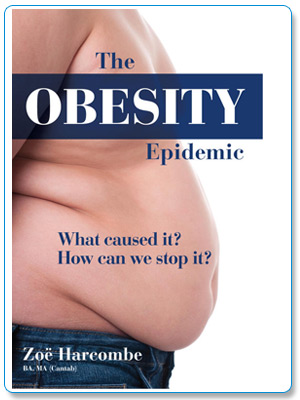References - Chapter 14
“Do more” – the role of exercise
281 Gary Taubes, “Why we gain weight. Adiposity 101 and the alternative hypothesis of obesity”, (6 May 2009). http://www.dhslides.org/mgr/mgr060509f/f.htm
282 www.caloriesperhour.com
283 Anton J.M. Wagenmakers, “Type 2 Diabetes: Insulin Resistance May Be the Result of Mitochondrial Dysfunction.” Public Library of Science Medicine, (2005).
284 William L. Haskell, I-Min Lee, Russell R. Pate, Kenneth E. Powell, Steven N. Blair, Barry A. Franklin, Caroline A. Macera Gregory W. Heath, Paul D. Thompson and Adrian Bauman, “Physical Activity and Public Health: Updated Recommendation for Adults from the American College of Sports Medicine and the American Heart Association”, (2007). And in turn, the reference from within this document is:
Saris, W. H., S. N. Blair, M. A. Van Baak, et al, “How much physical activity is enough to prevent unhealthy weight gain? Outcome of the IASO 1st Stock Conference and consensus statement”, Obesity Research, (2003).
285 Swinburn B., “Increased energy intake alone virtually explains all the increase in body weight in the United States from the 1970s to the 2000s”, 2009 European Congress on Obesity, (May 6-9, 2009). Abstract T1:RS3.3.
286 (*) http://www.theheart.org/article/970183.do
287 (*) http://abbottnutrition.com/Products/similac-isomil-advance
288 (*) “Britons watch a day of television every week”, The Daily Telegraph, (10 February 2010). http://www.telegraph.co.uk/culture/culturenews/7202729/Britons-watch-a-day-of-television-every-week.html
289 www.caloriesperhour.com is the calculator used for consistency throughout this book. This is one of the more sophisticated calculators available on the internet, as it allows for weight variation and time variation for hundreds of different activities.
290 Centers for Disease Control and Prevention, “Adult participation in recommended levels of physical activity: United States, 2001 and 2003”, MMWR 54:1208–1212, (2005).
291 Centers for Disease Control and Prevention, “Trends in leisure time physical inactivity by age, sex and race/ethnicity – United States – 1994–2004”, MMWR 54:991–994, (2005).
292 Ross C. Brownson & Tegan K. Boehmer, “Patterns and Trends in Physical Activity, Occupation, Transportation, Land Use, and Sedentary Behaviors”, (2005).
293 John Cloud, “Why exercise won’t make you thin”, Time Magazine, (17 August 2009).
294 http://www.ingnycmarathon.org/Results.htm
295 Robinson, J. P., and G. Godbey, Time for Life. The Surprising Ways Americans Use Their Time, The Pennsylvania University Press, University Park, (1999).
296 Flegal, K. M., M. D. Carroll, C. L. Ogden, and C. L. Johnson., “Prevalence and trends in obesity among U.S. adults, 1999-2000”, Journal of the American Medical Association, (October 2002).
297 Mary E. Moore, Albert Stunkard, Leo Srole, “Obesity, Social Class, and Mental Illness”, Journal of the American Medical Association, (1962).
298 Albert Stunkard, “Obesity and socioeconomic status – a complex relation”, The New England Journal of Medicine, (September 1993).
299 Sproston K, Primatesta P., Health Survey for England 2002. The health of children and young people. London: The Stationery Office, (2003).
300 Rebecca Wilcox, UK BBC 3, Who made me fat? (30 October 2009). Repeated on BBC 1 (1 March 2010).
301(*) http://www.drfosterintelligence.co.uk/newsPublications/localDocuments/WeighingUpTheBurdenOfObesityReport.pdf
302 (*) http://www.assemblywales.org/07-051.pdf
303 Newburgh L.H., “Obesity”, Archives of Internal Medicine, (1942).
304 Presenter Nick Cohen, Channel 4, “30 Minutes”, (Aired 1 May 2004).
305 New York Post, (13 August 2008).
306 http://www.earlybirddiabetes.org/index.php
307 Katie M Mallam, Brad S Metcalf, Joanne Kirkby, Linda D Voss, Terence J Wilkin, “Contribution of timetabled physical education to total physical activity in primary school children: cross sectional study”, British Medical Journal, (2003).
308 Ali A. Berlin, Willem J. Kop, Patricia A. Deuster, “Depressive Mood Symptoms and Fatigue After Exercise Withdrawal: The Potential Role of Decreased Fitness”, Psychosomatic Medicine, (2006).
309 (*) http://www.ergoweb.com/news/detail.cfm?id=1188
310 (*) http://child-abuse.suite101.com/article.cfm/statistics_on_child_abduction
311 Department of Health, At least five a week, (April 2004).

